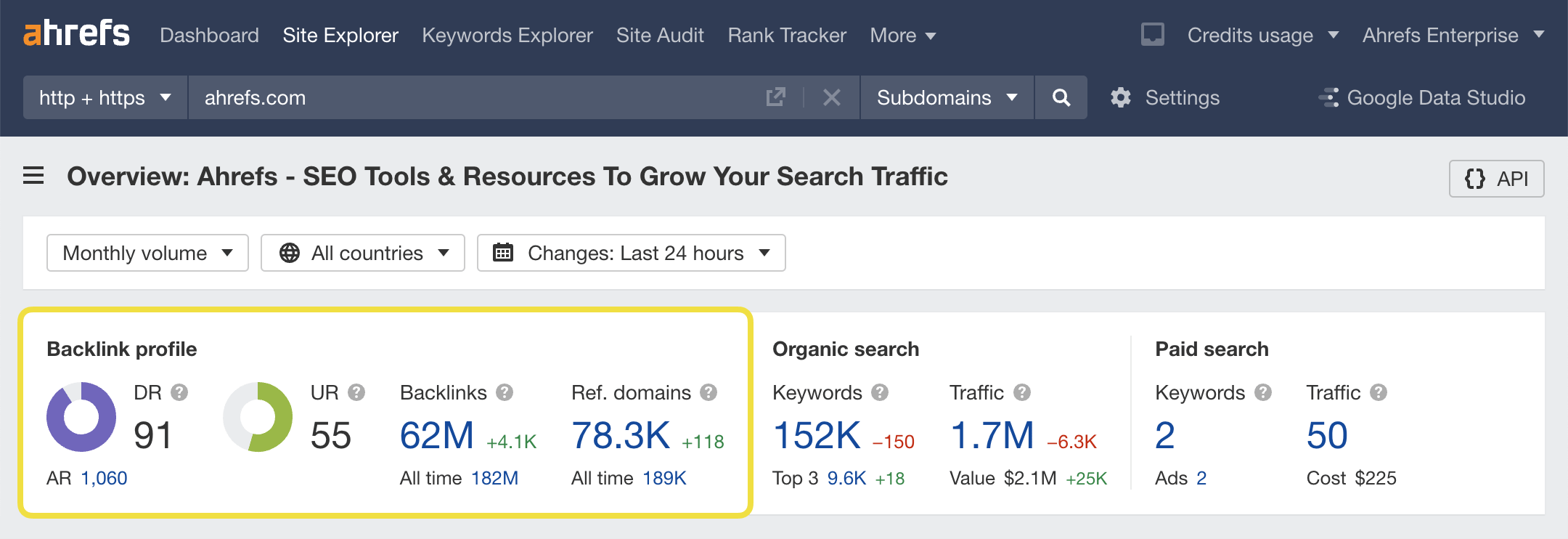Increase your credibility with search engines (and readers) with reputable backlinks.
Search engine optimization (SEO) is a huge topic, but there are several fundamental SEO tactics that have an outsized impact on organic visibility.[1] Monitoring (and earning) backlinks is one of those key fundamentals, especially for smaller businesses just getting started with search.
Put simply: A strong backlink profile is one of the important aspects of a successful SEO presence. Relevant sites linking back to yours is a signal to search engines that your content is high quality and authentic.
Understanding how backlink profiles work as you grow your SEO footprint will allow you to seek out those placements as part of your strategy, ensuring that your search presence grows meaningfully and responsibly.
What is a backlink profile?
A backlink profile is made up of all the links on the web that direct visitors to a business’ site. In addition to the total number, it also provides information like the types of links, their relevance to the subject matter, the domain authority of the referring website, and the quality of the anchor text that contains the link.The backlink profile goes hand in hand with a business’ overall keyword profile to tell the story of how authoritative and trusted a site is. Having a strong profile also makes it easier to achieve a higher search engine ranking, earn more traffic to a page, and be recognized as a credible source within a niche. Higher rankings result in a company’s site gaining more exposure to search queries which leads to increased organic traffic and a stronger reputation on search engines.
Where can I find my backlink profile?
To find your backlink profile, you will need some form of SEO software. There are free versions of popular tools available online that you can try before making a financial commitment. If you have a digital marketing or SEO agency, they can also help access and assess your backlink profile.

An example of a backlink profile checker from Ahrefs[1]
Why is a strong backlink profile important?
A strong backlink profile signals to search engines that your site is relevant and authoritative within your subject matter and industry. It also indicates that the other players in your space—whether they be individual bloggers, thought leaders, or publications—see your content as trustworthy enough to share in their own writing. In this way high quality backlinks from trusted sources (i.e., an authoritative website in a space sharing your content) builds trust in your brand.
Working to establish a strong backlink profile from the outset can also pull double duty with work to build your overall keyword profile. As you select keywords to rank for with your SEO tactics, consider the types of terms that you’d want to target as potential backlinks.
Consider these questions as you work on your link profile and strengthen your link building strategy:
What are industry leaders in your space talking about?
Which publications have you identified as potential sources for quality backlinks?
Where do industry players gather online?
Who can you engage with to begin the process of building trust and earning reputable backlinks?
What are the challenges of building a strong backlink profile?
As search engines get more sophisticated, so do the ways they identify content as worthy of being shared (or not). Over the years, SEO strategy and tactics have changed drastically from the wild west days of link exchanges, keyword stuffing, and spammy anchor text. Now, businesses and content creators have to be more thoughtful than ever about how they present their content online.
Readers don’t want to see less-than-useful content. Search engines know this and are getting smarter every year at rewarding good content and relegating bad content. Building an effective backlink profile from scratch—especially a small business with limited resources—takes time, dedication, and in most cases money.
/ Related reading
Want to see how your current approach to SEO stacks up? Check out our article on the subject here: How To Measure the ROI of Your SEO Strategy
What factors make for a good backlink profile?
As you embark on this process, it’s important to know what you’re aiming for when it comes to collecting (or denying) backlinks. Here are five factors that contribute to a healthy backlink profile:
Backlinks contain minimal spam: A strong backlink profile will avoid backlinks that contain keyword stuffing, spammy anchor text, or other less-than-ideal SEO practices.
High authority, organic backlinks are maximized: Target natural backlinks from reputable websites that are earned naturally i.e., through the referring domain sharing your content organically.
Backlinks are diverse: Ideally, backlinks will come from a diverse set of sources while maintaining quality and specificity. This diversity also includes aspects like where your site is being shared (social, email, blogs, etc.) and by whom (individuals, other companies, thought leaders, etc.).
Low authority and low quality backlinks are minimized: Consider disavowing low quality and low authority backlinks that will dilute your overall profile.
Backlinks are relevant to your niche: Ensure that the majority of external backlinks come from relevant websites that pertain to your business’ niche, industry, or specific subject matter.
What does a bad backlink profile look like?
A key rule of thumb to follow is quality over quantity. One valuable backlink is worth 20 low quality links. To avoid a messy and ineffective backlink profile, follow the guidelines above to ensure you don’t have irrelevant backlinks from low authority sites diluting your presence.
For example, a business may have a huge amount of backlinks that originate from many sources. This seems good at face value, but those sources aren’t relevant to the business’ subject matter, they engage in less-than-ideal SEO tactics, and they aren’t seen as high authority by search engines. A spammy link does more harm than good to your profile despite the idea that many businesses linking back to you is a good thing.
/ Measure twice and cut once
Be extra mindful when building your profile from scratch as you have the opportunity to minimize these instances early on, and remember: quality over quantity!
What resources are needed to monitor and improve your backlink profile?
Technology
In order to effectively tackle the task of monitoring and improving your backlink profile, you’ll need an SEO tool. There are free options online to get started with paid versions that offer more sophisticated features. At the outset, though, merely having access to a tool that lets you view your backlink profile is a great place to start improving your SEO efforts.
Expertise
If you don’t have an SEO specialist on staff, the good news is there are tons of free resources online to learn about SEO and backlink analysis. Resources like The Moz Blog are excellent places to learn about all things search, and you can get up to speed on the basics with no financial investment required.
Support
Sometimes a little help goes a long way. If you’re at a point where you’re ready to invest into a long-term SEO strategy, it may be time to bring in some help in the form of an SEO or digital marketing agency. These companies have the staff, expertise, and time to help you parse aspects of your program such as your keyword profile, backlink profile, and search competitiveness.
/ Related reading
Want to learn more about what a service provider can do for you? Check out the Capterra hiring guides for SEO and digital marketing services for detailed info:
Putting it all together to grow your search footprint responsibly
By establishing a strong backlink foundation in the form of relevant, quality backlinks from authoritative sources, you stand to grow your search engine footprint responsibly and sustainably. Remember, quality is the goal when it comes to backlinks, so instead of casting a wide net, focus on grassroots engagement with key players in your niche.
These can be thought leaders, other companies in the space, or subject matter experts producing relevant content. The idea is to enter the online conversation with an authentic presence, and—perhaps more importantly—provide value to those reading. Doing this in earnest will establish you as one of those key industry players, making you more discoverable on search engines and increasing your authority in the marketplace.
Ready to learn more about all things SEO? Keep an eye on the Capterra blog, and start with these helpful resources:
